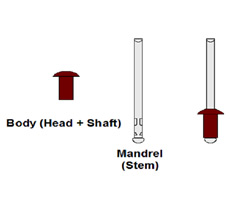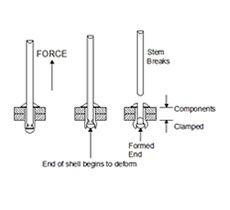
General Information
The "Grip Range" or total thickness of materials to be fastened, plus the rivet diameter is equal to the ideal Blind Rivet length. eg.
Material thickness = 10mm
Blind Rivet diameter = 4.8mm
10mm + 4.8mm = 14.8mm
∴ choose a rivet length of 15mm
Note: Rivet length should be measured from under head (flange) to end of shaft. Steel mandrel head should not be included.
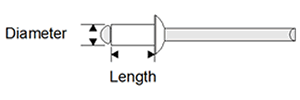
When calculating the suitable length of a Peeled rivet, take the total thickness of materials to be fastened and add on double the rivets diameter. eg.
Material thickness = 10mm
Blind Rivet diameter = 4.8mm x 2 = 9.6mm
10mm + 9.6mm = 19.6mm
∴ choose a rivet length of 18/21mm
grooved/multigrip rivets |
||
|---|---|---|
| 2.4mm | 2.5mm | 2.6mm |
| 3.2mm | 3.3mm | 3.4mm |
| 4.0mm | 4.1mm | 4.2mm |
| 4.8mm | 4.9mm | 5.0mm |
| 6.4mm | 6.5mm | 6.6mm |
Tensile and Sheer strengths:
| Aluminium | |
| Steel | |
| Nickel Copper Alloy | |
| Stainless Steel |
Types of Blind Rivets
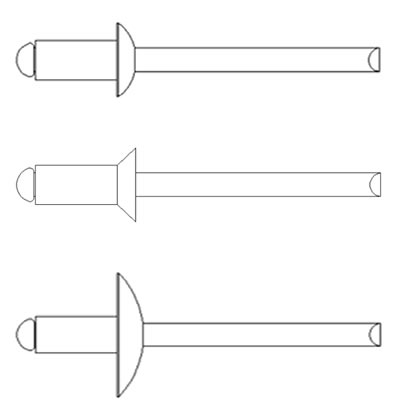
Open Type
Wide range of products in different body materials and head styles. For use where applications do not have high load bearing requirements.
Head Styles
- Dome Head
- Countersunk Head
- Large flange Head: Use when the head is in direct contact with a softer material, eg Plastic, wood, fiberglass, etc.
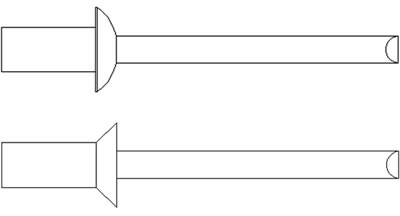
Closed End Type (Sealed)
Where the riveted joint should be water-/pressure-tight, eg Roofing.
Head Styles
- Dome Head
- Countersunk Head

Peeled Type
Suitable for joining plastics, rubber, wood and laminates. Widely used in the assembly of caravans, trailers, furniture, plastic-framed windows - any products involving joining of soft or friable materials.
Tolerant of oversized holes, 'Peel' can draw together and clamp poorly aligned components.

Grooved Type
For fixing into soft base materials such as wood and plastic.

Multigrip
Wide grip range. Ideal for inconsistent holes.
Common causes of poor riveter performance:
Jammed Mandrel
Mandrel from previous rivet not ejected - EJECT MANDREL.
Wrong nose-piece for rivet diameter - USE CORRECT DIAMETER.
Jaws do not grip
Jaw teeth clogged - CLEAN JAWS WITH WIRE BRUSH.
Jaws sticking on inside of jaw case - OIL LIGHTLY THROUGH NOSE-PIECE.
Insufficient tool stroke
Rivet too long for workpiece - USE SHORTER RIVET.
Nose-piece too large for the rivet - USE CORRECT NOSE-PIECE.
Thread stripping on nose-piece
Nose-piece fitted loosely into tool - TIGHTEN WITH SPANNER.

